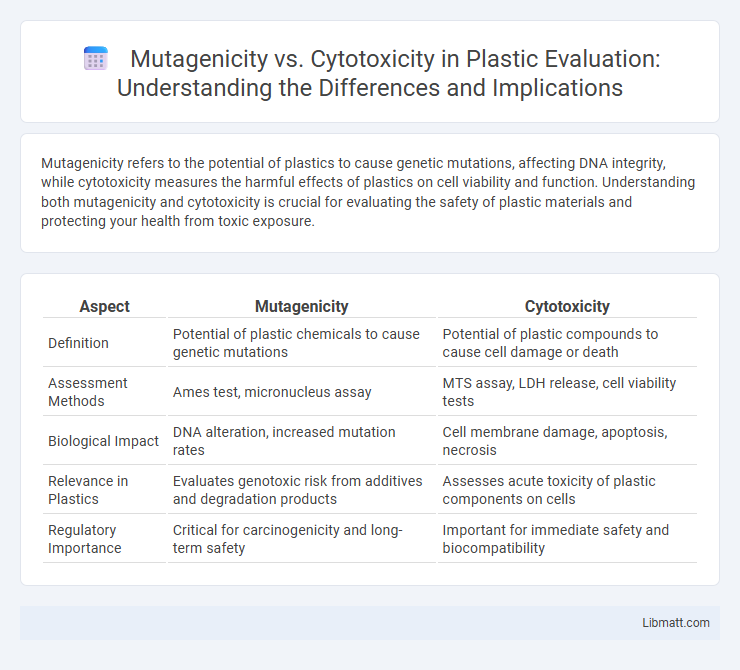Mutagenicity refers to the potential of plastics to cause genetic mutations, affecting DNA integrity, while cytotoxicity measures the harmful effects of plastics on cell viability and function. Understanding both mutagenicity and cytotoxicity is crucial for evaluating the safety of plastic materials and protecting your health from toxic exposure.
Table of Comparison
| Aspect | Mutagenicity | Cytotoxicity |
|---|---|---|
| Definition | Potential of plastic chemicals to cause genetic mutations | Potential of plastic compounds to cause cell damage or death |
| Assessment Methods | Ames test, micronucleus assay | MTS assay, LDH release, cell viability tests |
| Biological Impact | DNA alteration, increased mutation rates | Cell membrane damage, apoptosis, necrosis |
| Relevance in Plastics | Evaluates genotoxic risk from additives and degradation products | Assesses acute toxicity of plastic components on cells |
| Regulatory Importance | Critical for carcinogenicity and long-term safety | Important for immediate safety and biocompatibility |
Introduction to Plastics Evaluation
Plastics evaluation involves assessing mutagenicity and cytotoxicity to determine potential health risks associated with plastic materials. Mutagenicity tests identify genetic mutations caused by chemical exposure, while cytotoxicity tests measure cell damage or death, providing critical data on biological safety. Your comprehensive plastics evaluation relies on these assays to ensure compliance with regulatory standards and safeguard human health.
Defining Mutagenicity in Plastics
Mutagenicity in plastics refers to the ability of plastic materials or their additives to cause genetic mutations, potentially leading to DNA damage and cellular abnormalities. Evaluating mutagenicity involves identifying substances within plastics that may induce mutations in living cells, which is critical for assessing long-term health risks associated with plastic exposure. Your safety assessments must differentiate mutagenic effects from cytotoxicity, which relates to cell damage or death, to comprehensively evaluate plastic-related hazards.
What is Cytotoxicity?
Cytotoxicity refers to the quality of being toxic to cells, causing cell damage or cell death, which is a critical parameter in evaluating the safety of plastics. It assesses the impact of plastic materials on cell viability, proliferation, and membrane integrity by measuring cell metabolic activity, often using assays like MTT or lactate dehydrogenase (LDH) release. Understanding cytotoxicity helps identify potentially harmful plastic additives or degradation products that may impair tissue compatibility or human health during prolonged exposure.
Key Differences: Mutagenicity vs Cytotoxicity
Mutagenicity evaluates a substance's potential to cause genetic mutations, impacting DNA and leading to long-term health risks such as cancer. Cytotoxicity measures the immediate toxic effects on cell viability and function, indicating cell damage or death from exposure to plastics. Your assessment of plastics safety should prioritize mutagenicity for genetic damage risk and cytotoxicity for acute cellular harm.
Importance of Mutagenicity Testing in Plastics
Mutagenicity testing in plastics evaluation is crucial for identifying potential genetic mutations caused by chemical additives or degradation products, ensuring consumer safety and regulatory compliance. This testing complements cytotoxicity assessments by detecting DNA damage risks that cytotoxicity alone may overlook, providing a comprehensive hazard profile. You can rely on mutagenicity data to prevent long-term genetic harm from plastic exposure, enhancing product safety and environmental protection.
Role of Cytotoxicity Assays in Plastic Safety
Cytotoxicity assays are essential in plastic safety evaluations as they measure the potential toxic effects of plastic compounds on living cells, providing early indicators of material biocompatibility and safety. These assays complement mutagenicity tests by identifying cellular damage or death caused by plastic additives or degradation products, helping to prevent adverse health effects. Incorporating cytotoxicity data enhances risk assessment by highlighting harmful interactions that may not induce mutations but still compromise cellular function.
Standard Methods for Assessing Mutagenicity
Standard methods for assessing mutagenicity in plastics evaluation primarily utilize in vitro assays such as the Ames test, which detects gene mutations in specific strains of Salmonella typhimurium. Mammalian cell assays, including the mouse lymphoma assay and micronucleus test, are also employed to evaluate chromosomal damage and gene mutations at the cellular level. These standardized tests follow guidelines from organizations like OECD to ensure reproducibility and regulatory compliance in detecting mutagenic potential of plastic components.
Common Cytotoxicity Testing Approaches
Common cytotoxicity testing approaches in plastics evaluation include the MTT assay, which measures cellular metabolic activity, and the LDH assay, detecting membrane integrity disruption. These methods help assess the potential harmful effects of plastic additives or degradation products on cell viability. Your selection of appropriate assays depends on the specific type of plastic and its intended application to ensure accurate toxicity profiling.
Regulatory Guidelines for Plastics Safety Evaluation
Regulatory guidelines for plastics safety evaluation emphasize the assessment of mutagenicity and cytotoxicity to ensure consumer health protection. Standardized tests such as the Ames test for mutagenicity and ISO 10993-5 for cytotoxicity are mandated by regulatory agencies like the U.S. FDA and the European Chemicals Agency (ECHA) to evaluate potential genetic mutations and cell viability impacts. Compliance with these frameworks supports the comprehensive risk assessment of plastic materials used in medical devices, food packaging, and consumer products.
Implications for Human Health and Environmental Safety
Mutagenicity assessment of plastics evaluates the potential genetic damage caused by chemical leachates, which can lead to mutations and increase cancer risk, highlighting critical human health concerns. Cytotoxicity testing measures cell viability reduction, indicating harmful effects on cellular function that can impair tissue and organ health in exposed populations. Together, these evaluations inform regulatory decisions and material selections to ensure safer plastic use, minimize environmental contamination, and protect both ecosystems and public health.
Mutagenicity vs cytotoxicity (plastics evaluation) Infographic

 libmatt.com
libmatt.com